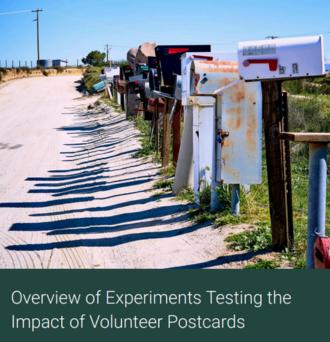
Environmental Voter Project (EVP) released a new report highlighting key findings from multiple randomized controlled trials conducted from 2022–2025 testing which types of volunteer-written postcards tend to increase turnout among low propensity voters.
Actionable findings from the report:
- The Gold Standard. EVP’s research shows that volunteer postcards that highlight “loss aversion” messaging — yet also include some social pressure language — have increased turnout among low-propensity voters in multiple randomized controlled trials across elections with varying levels of turnout. Unfortunately, loss aversion messaging can’t be used with every low-propensity voter in every election because (a) the messaging must reference a recent higher-turnout election, and (b) the targeted low-propensity voters must have actually voted in that recent higher-turnout election.
- A Promising Alternative. “Trending norms” messaging shows promise for volunteer postcarding campaigns and can be used to target almost any low-propensity voter in almost any jurisdiction (assuming that jurisdiction’s underlying voter-turnout numbers show an upward trend). EVP’s research has shown that this message (a) yields successful results in direct mail campaigns, and (b) can easily be transferred to volunteer postcards, but more research is needed before we can fully recommend its use as a stand-alone voter-turnout intervention.
- A Nice Try. Although “friends and family” messaging has increased voter turnout in non-mail interventions, we do not currently have evidence that “friends and family” volunteer postcards increase voter turnout.
